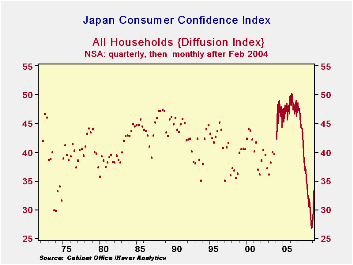 Global| May 18 2009
Global| May 18 2009Japan's Consumer Confidence Is Up For The Fourth Month In A Row
Summary
Japan’s consumer confidence index is up for the fourth month running. It is now a monthly reading - that accounts for the history of dots on the chart which represent unconnected quarterly observations ahead of the adoption of monthly [...]

Japan’s consumer confidence index is up for the fourth month
running. It is now a monthly reading - that accounts for the history of
dots on the chart which represent unconnected quarterly observations
ahead of the adoption of monthly surveys. The current reading for the
index is in the bottom third to quarter of its historic range, a low
position, but well off from its worst in this cycle. Notably, over the
last three months there have been sharp improvements in the overall
livelihood assessment. Income growth, Employment, Willingness to buy
durables, and Value of assets responses, all have risen over that
period. Of these, income growth is still the lowest in its range
standing in the bottom 11th- to 15th percentile depending on the period
for that calculation. Employment and value of assets responses lie just
below the boundary for the lower range quartile. Willingness to buy
durable goods is, however, much stronger in its range and is closer to
the midpoint at the 45th range percentile.
Clearly there has been improvement in the Japanese consumer’s
assessment of the economy. Just as clearly the current readings on the
consumer’s feeling about the economy are poor. For now after such a
lengthy period of deterioration what is notable is the ongoing
improvement in these measures and quite a notable step of improvement
across the various responses. However bad off things are in Japan, they
are perceived to be getting better. Importantly these assessments are
not so beleaguered for spending any more.
| Japan Consumer Confidence | Percentile | |||||||
|---|---|---|---|---|---|---|---|---|
| monthly | Change over | of range* | ||||||
| Apr-09 | Mar-09 | Feb-09 | 3-mos | 6-mos | 12-Mos | Since 2004 | Since 1988 | |
| Overall Livelihood | 33.8 | 31.1 | 29.4 | 4.6 | 4.2 | 0.8 | 28.6 | 26.1 |
| Income growth | 33.4 | 32.0 | 31.1 | 2.0 | -1.1 | -4.1 | 15.1 | 11.1 |
| Employment | 23.3 | 18.3 | 14.9 | 9.1 | -1.5 | -12.7 | 22.2 | 22.2 |
| Willing to buy Durable Goods | 39.0 | 34.2 | 31.4 | 8.4 | 10.2 | 4.8 | 45.9 | 45.3 |
| Value of Assets | 32.2 | 28.8 | 28.7 | 4.1 | 3.2 | -4.1 | 22.4 | 22.4 |
| For two-person households; * Percentiles since Mar 2004 when series became monthly or full period | ||||||||
Robert Brusca
AuthorMore in Author Profile »Robert A. Brusca is Chief Economist of Fact and Opinion Economics, a consulting firm he founded in Manhattan. He has been an economist on Wall Street for over 25 years. He has visited central banking and large institutional clients in over 30 countries in his career as an economist. Mr. Brusca was a Divisional Research Chief at the Federal Reserve Bank of NY (Chief of the International Financial markets Division), a Fed Watcher at Irving Trust and Chief Economist at Nikko Securities International. He is widely quoted and appears in various media. Mr. Brusca holds an MA and Ph.D. in economics from Michigan State University and a BA in Economics from the University of Michigan. His research pursues his strong interests in non aligned policy economics as well as international economics. FAO Economics’ research targets investors to assist them in making better investment decisions in stocks, bonds and in a variety of international assets. The company does not manage money and has no conflicts in giving economic advice.






